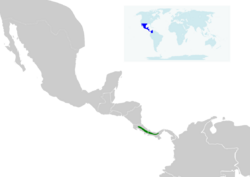Biology:Collared whitestart
| Collared whitestart | |
|---|---|

| |
| In Costa Rica | |
| Scientific classification | |
| Domain: | Eukaryota |
| Kingdom: | Animalia |
| Phylum: | Chordata |
| Class: | Aves |
| Order: | Passeriformes |
| Family: | Parulidae |
| Genus: | Myioborus |
| Species: | M. torquatus
|
| Binomial name | |
| Myioborus torquatus (Baird, 1865)
| |

| |
The collared whitestart (Myioborus torquatus), also known as the collared redstart, is a tropical New World warbler endemic to the mountains of Costa Rica and western-central Panama.[2]
Description
The collared whitestart is around 13 centimetres (5 in) in length with a weight of 10.5 grams (0.4 oz). It has a chestnut crown bordered with black, and a black forehead. The rest of the upper parts are slaty black, and the tail is black with white edges, hence the bird's name: "start" is an old English word for "tail". The face and underparts are bright yellow, with a black band across the breast.[2]
The sexes are similar, but young birds are duller, with a browner back, weakly yellow underparts, and the head entirely slate-coloured, with no yellow on the face or red on the crown.[citation needed]
Behaviour
This section does not cite any external source. HandWiki requires at least one external source. See citing external sources. (April 2019) (Learn how and when to remove this template message) |
The call is a sharp pit, and the song is a mixture of slurred whistles, warbles and trills.
The collared whitestart feeds on insects, frequently fanning its striking tail as it pursues its prey. It will join mixed feeding flocks, and will follow cattle and occasionally humans for the insects they flush.
The roofed nest has a round side entrance and is built on the ground or a steep bank, hidden amongst rocks, tufts of grass or under a fallen log. It is constructed from strips of bark, plant fibres, leaves, and grass. From March to May, the female will lay 2 or 3 white or cream eggs that are speckled with fine brown spots. Incubation lasts about two weeks, but other nesting details are largely unknown.
Habitat
The collared whitestart is common at heights between 1500 m and the timberline in mossy mountain forests, ravines, second growth, and adjacent pastures.[2]
References
- ↑ BirdLife International (2020). "Myioborus torquatus". IUCN Red List of Threatened Species 2020: e.T22721934A137114670. doi:10.2305/IUCN.UK.2020-3.RLTS.T22721934A137114670.en. https://www.iucnredlist.org/species/22721934/137114670. Retrieved 12 November 2021.
- ↑ 2.0 2.1 2.2 Jon Curson (2010). New World Warblers. Bloomsbury Publishing. pp. 200–201. ISBN 9781408135167. https://books.google.com/books?id=mPPUBAAAQBAJ&pg=PA200.
- Curson, Quinn and Beadle, New World Warblers ISBN:0-7136-3932-6
- Stiles and Skutch, A guide to the birds of Costa Rica ISBN:0-8014-9600-4
Further reading
- Skutch, Alexander F. (1954). "Collared redstart". Life Histories of Central American Birds. Pacific Coast Avifauna, Number 31. Berkeley, California: Cooper Ornithological Society. pp. 371–376. https://sora.unm.edu/sites/default/files/journals/pca/pca_031.pdf#page=369.
External links
Wikidata ☰ Q1156543 entry
 |


